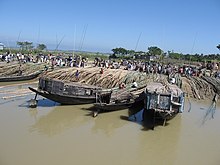Haor
A haor (Bengali: হাওর)[a] is a wetland ecosystem in the north eastern part of Bangladesh which physically is a bowl or saucer shaped shallow depression, also known as a backswamp.
In Bangladesh and in the deltaic part of the Indian state of West Bengal, which lie in the floodplain of three great rivers, the Bengali language has several terms to differentiate between lakes, including baor, haor, jheel and beel.
[10][9] A baor or jheel is an oxbow lake,[11] namely moribund beds of the Bhairab, Kaliganga, Gorai and Kumar rivers.
[12] A simple definition was provided by hydrologist Saila Parveen, "Haor – seasonal wetland, baor – oxbow lake, and beel – perennial water body.
"[13] Jheels or baors are found mostly in the moribund delta as in greater Comilla, Faridpur, Dhaka and Pabna districts.
[14] In a country where one third of all area can be termed as wetlands,[15] the haor basin is an internationally important[citation needed] wetland ecosystem, spread over Sunamganj, Habiganj, Moulvibazar districts and Sylhet Sadar Upazila, as well as Kishoreganj and Netrokona districts outside the core haor area.
It is a mosaic of wetland habitats, including rivers, streams and irrigation canals, large areas of seasonally flooded cultivated plains, and hundreds of haors and beels.
[7] The haor basin is bounded by the hill ranges of India – Meghalaya on the north, Tripura and Mizoram on the south, and Assam and Manipur on the east.
[10] The basin extends north to the foot of the Garo and Khasia Hills, and east along the upper Surma Valley to the Indian border.
[1][18] Some of the most extensive seasonally flooded areas in South Asia are situated in bowl-shaped depressions known as haors located between the natural levees of rivers subject to overflow during the monsoon.
[1] It remains under water for seven months of the year, turning haor settlements mostly built on earthen mounds into islands.
[1][20] The fight against natural calamity of the locals people, mostly day laborers, relies on traditional and indigenous methods which with limited effect.
[1] The Haor Basin is the only region in Bangladesh where remnant patches of freshwater swamps and reed lands still exists.
[4] Only a few patches remain of the swamp forests that once dominated the area, featuring flood tolerant trees like Hijal (Barringtonia acutangula) and Koroch (Pongamia pinnata).
[5] The hijal or hual, korij or koroch, bhui dumur (Ficus heterophylla), nol (Arundo donax), khagra (Pharagmites karka), ban golap (Rosa involucratia) and barun (Crataeva nurvala) are the main plant species found in the swamp forests.
[2] Other plant species available in the wetlands include madar (Erythrina variegata), gab (Diospyros peregrina), makna (Euryale ferox), singara (Trapa bispinosa), jaldumur (a kind of Ficus), chitki (Phyllanthus reticulatus), thankuni (Centella asiatica), kalmi (Ipomoea aquatica), helencha (Enhydra flactuans), hogla (Typha elephantina), duckweed, water hyacinth, lotus and water lily.
[24] It is believed that the early settlers of the area were Hindus and other ethnic groups including Garo, Hajong, Khasi and Koch people coming down from the hills to the north.
[24] From the 1780s, population and area under cultivation declined till early 20th century, mostly due to successive natural calamities including floods and earthquakes.
[28] International Union for Conservation of Nature (IUCN) considers the increase in tourist traffic as "a potential opportunity for the haor dwellers for improving their livelihoods.










